Control, Alt, Delete?
Two anthologies published last year, Curating Immateriality: The Work of the Curator in the Age of Network Systems and Art and its Institutions: Current Conflicts, Critique and Collaborations attempt to grasp a ‘world art world’ undergoing profound transformation within the ‘horizontal’ and globalised matrix of post-fordism. But how impartial are the diagnoses of art world professionals, and indeed how ingenuous the calls for democratisation from within their left-liberal ranks?, asks Jonathan Harris
I met my first computer in about 1990 when the device seemed simply to be a clever way of writing onto a screen before deciding what your final order and selection of printed words would be. That was ‘research’; at ‘work’ (at what was then Leeds Polytechnic) the machines were still, like truffles, rather thin on the ground – I stuck to my old electric typewriter for memos and reports. Five years later, at Keele University, establishing a B.A. Degree for fine art students that asked them to do ‘half theory/half practice’, we decided to make use of computers a major part of the studio programme.[1] Photoshop replaced drawing, though the internet was still below the horizon – I was just about ‘online’ but had no knowledge of what I could do ‘there’. I had to buy a low-tech magazine to see lists of websites. I seemed to waste a lot of time waiting to download things that never arrived. Ten years and more on, at the University of Liverpool, I now spend about six hours a day sitting at my computer – at home, or at work – and virtually every administrative, pedagogic, ‘outreach’, and research support activity or task I perform I do via the screen and keyboard into which I am also typing this sentence.
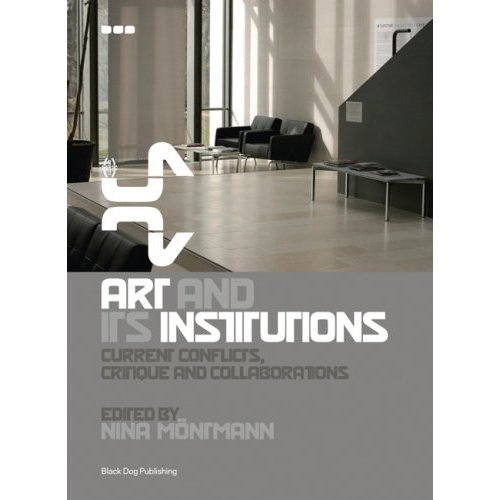
So it is as a rather jaded and irritable academic ‘operative’ – the job having been reduced, on the whole, to such a glorified clerical role – that I have been considering the claims and arguments presented in Curating Immateriality. Along with Art and Its Institutions (not a title likely to stand out much in a google search), the authors and contributors to Curating Immateriality (the third volume in the ‘DATA browser’ series) share a concern for the future of democracy, egalitarianism, open inquiry, experimentation, the organisation of institutions, and how these matters are related to a variety of overlapping ‘networks’ and ‘systems’.[2] The promiscuous metaphoricity of these, and other, terms may promise a kind of grand meta-analytic investigation, but the more I read – especially in Curating Immateriality – the more I found the use of the argot rather lazy and socially-excluding. Both books, in fact, are made up of essays and discussions by specialists (paid to do their work as professional curators, artists, administrators, and facilitators) largely for other specialists. Curating Immateriality more or less acknowledges this, while Art and Its Institutions – actually concerned in the main with Nordic art and society – though much more likely to find a wider readership, suffers from a number of poor translations. Its title is a little disingenuous as well as falsely generic: outside of the Scandinavian countries some of the main assumptions made in this book about the history and role of the modern state, the legitimacy of welfare-provision and egalitarian principles will appear contentious, poorly-argued, and jargon-ridden (for instance, in many parts of the USA).
Having said that, both books are well-intentioned and try to engage constructively with some of the fundamental problems faced by all people now: threats to social and cultural freedoms, to peaceful life around the world, and to the survival of the species caused by US-led global capitalism, neo-imperialism, and increasing competition for natural and technological resources of all kinds. The fact that art institutions, agencies, and agents of all kind active in the ‘art world’ now have to acknowledge the direct encroachment of these issues onto their territory indicates something of the extraordinary changes in world, and western culture, that have taken place since the mid 1960s – when (primarily in the western countries) artists and critics en masse abandoned the ideas, values, and practices associated with modernist art and its claimed cognitive, critical, social, and experiential autonomy.[3] Museums and galleries of virtually all kinds were slower and in many cases resistant to accept or take part in such transformation (the Museum of Modern Art in New York being paradigmatic here and examined by several authors in these two books), but – as Curating Immateriality and Art and Its Institutions testify – by the 1990s, for a variety of complex and interwoven factors, both publicly-funded state-run and charity-status privately-owned art institutions had become players, to greater or lesser extents, in debates and state policy initiatives concerned with citizenship, social regeneration, ‘social inclusion’, and multiculturalism. This development has occurred throughout the world, but is especially the case in the rich northern and western nation-states – and within conglomerate areas such as the European Union – whose funding agencies have contributed to visual arts institutional transformation in many of the examples discussed by Nina Montmann and her contributors.[4]
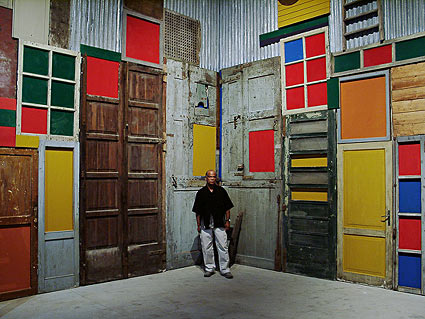 Image: Antonio Ole with his work Margem da Zona Limité: Township Wall, 1994-95, exhibited as part of The Structure of Survival, Venice Biennale, 2003
Image: Antonio Ole with his work Margem da Zona Limité: Township Wall, 1994-95, exhibited as part of The Structure of Survival, Venice Biennale, 2003
Both books importantly register also the changed character of what I have just called the ‘art world’ – an amorphous late-19th century coinage which indicated the recognition, then, that a ‘system’ of some kind (material and ‘immaterial’, visible and invisible, individual and social, state and civil) linked and over-determined the agents and artefacts, processes and practices, conventions and institutions concerned with constituting and reproducing modern art. In the 20th century this system grew exponentially both in size and in terms of the complexity of the range of its active determinations: the elements or ‘nodes’ (and the relays between them) comprising the system as a whole. If some historically earlier features actually disappeared – such as the dominance of a dictatorial national state art academy for the training and validation of artists and their artworks – then other emergent elements took their place, such as the creation of formally independent , or ‘arm’s length’, government-funded arts councils after the Second World War. Quantity leaps arguably led to qualitative changes: the extraordinary rise in mediation through print, TV broadcast, and now internet sources since the 1960s has given modern and contemporary art, and its critical interpretation, an unprecedented platform for exposure while more or less simultaneously – since Warhol’s time – decisively altering the character of much of the art world itself (especially the self-perception of artists).
‘Globalisation’ had been a feature of this quantitative and qualitative transformation throughout the 20th century – and earlier. But widespread public perception of a manifestly ‘world art world’ seems to have happened only since the 1990s, symbolised by the phenomena of art biennials and regular festivals held on at least four of the five continents. Globalisation, however – like postmodernism – fairly quickly became a cliché (the former emerging from the decayed hulk of the latter), though the significance of the developments to which the terms referred were not seriously doubted. The task posed by the editors of these two books, then, is to formulate through these essays, round-table discussions, and artists’ statements, ways to engage with and manipulate for politically progressive ends the ‘networks’ or ‘systems’ of contemporary art – understood as digital form and process, or as institutional rhizome, or as imposed state social-democratic injunction, or as global capitalist neo-liberal market, or as some or all of these combined in some total mega-system or mega-network.
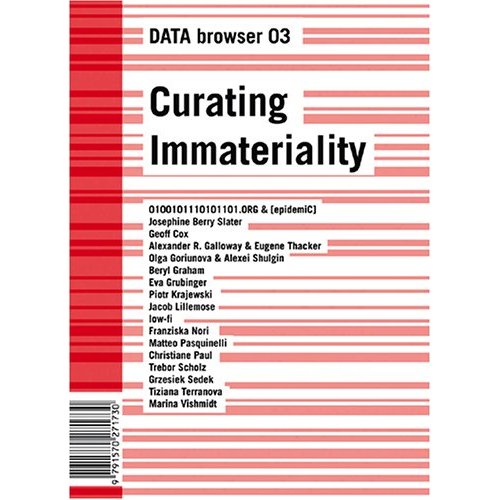
Both sets of contributors indicate – more or less – that what appears to be a socio-political and technological situation which might bring positive democratic change in our social orders (through ‘non-hierarchical’ digital systems or state-funding programmes) actually threatens more authoritarian control and a reduction in possibilities for experimental freedom in the arts, or in ways of organising community, or ways of generating enriched sociality and multiple, ‘agonistic’ public spheres. The tone of much of the discourse in these books is therefore curiously both recklessly utopian and pessimistically Adornoesque; an apparent paradox exemplified and prefigured by the slightly hysterical-sounding foreword by Cecilia Gelin, director of the Nordic Institute for the Contemporary Arts (NIFCA), sponsor of Art and its Institutions, which informs the reader that the organisation has just been closed down as part of a ‘restructuring’ process by the Nordic Council of Ministers. But this oscillation between ’60s-ish community arts triumphalism and neo-Orwellian angst seems to me to be symptomatic of the dilemmas caused when thinking and writing as specialists (or, in the case of Curating Immateriality, sometimes as computer-nerds) for other specialists. It will be very difficult to gain a credible impressionistic overview, never mind a sophisticated analytic understanding, of the ‘world art world’ from the position of an internal player with considerable stake in the system itself. The conditions of production of such knowledge of the system if you are a player tend to exclude this as a possibility because of one’s interests, financially and ideologically. This has got nothing to do with the undoubted ingenuousness, seriousness and intellectual abilities of any players attempting to generate such an analytic account. Many of the writers in both books – especially, I thought, Sven-Olov Wallerstein, Beatrice Von Bismarck, Jan Verwoert, Simon Sheick (in Art and its Institutions) and Christiane Paul, Marina Vishmidt, and Matteo Pasquinelli (in Curating Immateriality) demonstrate a formidable grasp of art-cultural-theoretical discourse, but the limits to their critiques (both to their specific intentions and general intelligibility) are set by the fact that they are talking, self-consciously or not, to other specialists and professionals in the system.
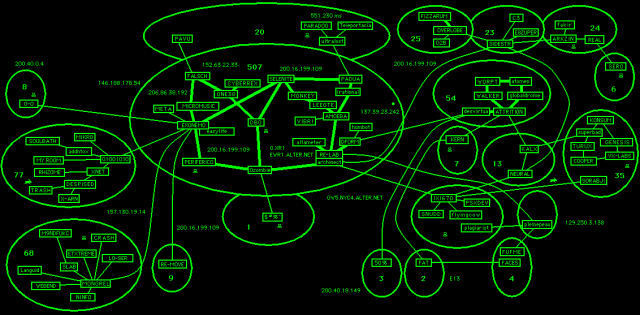 Image: Jodi, http://map.jodi.org – Jodi's map of the web
Image: Jodi, http://map.jodi.org – Jodi's map of the web
This kind of essentially closed, or self-referential, dialogue is a primary feature of the ‘world art world’ system itself – acknowledged by several contributors aware of it, and of its effects, as a species of ‘institutionalised institutional critique’. Several authors gesture towards leaving, if not ending, the system. Eva Grubinger, for instance, demonstrates quite a lot of resistance to the lure of the digital represented by her involvement with the C@C (Computer Aided Curating) project she helped develop in the 1990s. ‘Artists often embrace new technologies as a means in itself rather than a means to an end’, she notes, ‘they tend to fool themselves by the seemingly limitless possibilities of new techniques instead of focussing on the results, which are often embarrassing. Taken too seriously the immaterial qualities of a medium may result in yet more alienation from the physical environment …Unwillingly, artists and curators provided the avant-garde for [sic] a neo-liberal life-style, which pretends to free capitalism from the curse of oppression and bureaucratic routine but only introduces more subtle regimes of power that are not organised as pyramids but as networks.’ (Curating Immateriality: 108). This welcome scepticism regarding the metaphor/efficacy of the digital – figured as ‘flat’ system, as democratising ‘search engine’ for pluralities and freeing non-selection – is a markedly minor key in the book, but emphasises the point I began with: the usual, ‘democratic’, mundane experience of computers now is that they are a ‘sped-up’, post-Fordist work-tool. The idea of turning my screen off after hours (days, weeks, years) entering information on University data-bases and turning it on again five minutes later in order to ‘entertain’ myself as the ‘PC World’ ads suggest I should is utterly risible. But, for me anyway, it’s almost as hard to consider turning it back on to find websites on what’s really happening in Iraq, or even to do very basic things like book a holiday or buy a birthday present for someone (though I do use the internet for these things). That’s what happens when computers essentially mean work. The theoretical and political point is that the digital world ‘system’ – if abstracted, idealised, and posed as meaningful, self-sufficient, or as a potential vehicle of change outside of its actual socio-historical conditions of production and use (as it appears to me to be in many of the contributions to Curating Immateriality) – remains a fantasy maintained by clearly well-meaning people, the ‘user-specialists’, whose livelihoods remain bound up with the maintenance of these illusions. Given that we’ve been living with computers in offices and most other workplaces for ten years or more now, and seen and experienced the alienations and stresses they cause within work contexts, Curating Immateriality generally seems nostalgic, naïve, and outdated as social critique, if not as the quotidian professional ‘networking’ discourse of left-liberal specialists-talking-to-specialists inside the system.
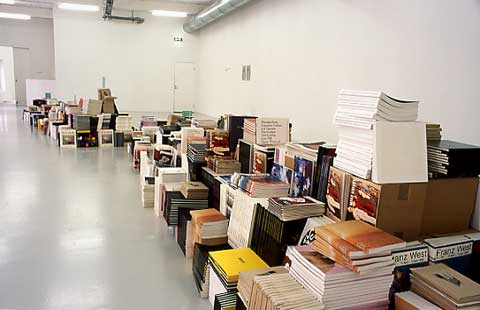 Image: Inatallation by Andreas Mangione, Rooseum, 2005. An installationn using the catalogues produced at Rooseum from its beginning
Image: Inatallation by Andreas Mangione, Rooseum, 2005. An installationn using the catalogues produced at Rooseum from its beginning
The same frustration with self-reference and closed systems – this time the art world system tout court – bursts out a few times in Art and its Institutions, most notably in the contributions by Andrea Fraser on museums as big-business, and by the artists/critics group consisting of Anthony Davies, Stephan Dillemuth, and Jakob Jakobsen. The latter’s piece, entitled ‘There is no Alternative: The Future is Self-Organised. Part 1’ is an old-fashioned piece of conceptual art anarchism. Its rhetoric merely refuses analysis of any kind – a kind of refreshing concession that artists and critics (as specialists), being within the system, really have no interest in critiquing it or rehabilitating it for democratic purposes: ‘All we need is their cash in order to pay our way out of capitalism and take this opportunity to make clear our intentions to supervise and mediate our own social capital, knowledge and networks…We put a lid on the bourgeois project, the national museums will be stored in their very own archive, the Institute of Contemporary Art will be handed over to the artists’ unions, the Universities and Academies will be handed over to the students, Siemens and all the other global players will be handed over to their workers. We need the state only as an administrative unit – just as neo-liberalism has suggested – but now with mechanisms of control, transparency, accountability and equal rights for all’ (Art and Its Institutions: 177-8). The rhetorical ‘demands’ and ‘planned actions’ stated here – the destruction of capitalism and empowerment of the popular masses – actually articulate what I presume lies beneath the many references to ‘democracy’, ‘pluralism’, ‘activism’, and ‘agonistic public spheres’ made by most contributors in all the other essays and in the documentation of art projects such as ‘Opacity’, although their language – as ‘specialists’ and professional players in the system – remains ambiguous, coded in acceptably vague state social-democratic discourse (after all: who could be ‘against democracy’?).
The declared anarchism of ‘There is no Alternative; The Future is Self-Organised. Part 1’ makes it an artwork, and the text functions as a kind of repressive tolerance valve in the book as a whole, although its comparative conceptual vulgarity may also have been intended (rhetorically) to help ‘save the ass of institutional critique’ which the collection as a whole constitutes. This phrase appears across the title page of Nina Montmann’s essay ‘Opacity: Current Considerations on Art Institutions and the Economy of Desire’ (101), indicating another structural feature of the ‘world art world’ discursive system: its specialists’ immersion in a kind of transatlantic Euro-American art-professional English argot mixed up with occasional deference to linguistic populism (think of the critic Mathew Collings). What Curating Immateriality and Art and Institutions both generally lack, then, is recognition of the professionalised exclusions their own discourses generate as well as sobering insights into the systemic-institutional limitations bearing upon the merely specialist radicalisms they espouse.
[1] See my account of the Keele programme, ‘Art Education and Cyber-Ideology: Beyond Individualism and Technological Determinism’, Art Journal Fall 1997, vol. 56, no. 3: 39-45.
[2] The New Shorter OED states that the older term, ‘network’, emerged in the late-19th century (to ‘cover with a network’), while ‘systems’ – pluralised, often hyphenated, and suggesting homogenised analytic data fields – is a sui generis mid-twentieth century term.
[3] See, for instance, Francis Frascina Art, Politics and Dissent: Aspects of the Art Left in Sixties America (Manchester University Press: Manchester and New York: 1999) and Christoph Grunenberg and Jonathan Harris (eds.) Summer of Love: Psychedelic Art, Social Crisis and Counterculture in the 1960s (Tate Liverpool and Liverpool University Press, Liverpool: 2005).
[4] On the continuing and future instrumentalisation of art within state funding regimes, see the important collection edited by Maria Lind and Raimund Minichbauer European Cultural Policies 2015. A Report with Scenarios on the Future of Public Funding for Contemporary Art in Europe (Iapsis, Stockholm: 2005).
Curating Immateriality: The Work of the Curator in the Age of Network Systems ed. Joasia Krysa (DATA browser 03, Autonomedia: Brooklyn, NY: 2006; 282pp, ISBN 1-57027-173-93) Art and Its Institutions: Current Conflicts, Critique and Collaborations ed. Nina Montmann (Black Dog: London, 2006; 191pp, ISBN 1904772 50 1)
Jonathan Harris <jharris1 AT liverpool.ac.uk> is professor of art history and director of the Centre for Architecture and the Visual Arts (CAVA) at the University of Liverpool. His Art History: The Key Concepts was published by Routledge in 2006, and his edited collection, Dead History, Live Art? Spectacle, Subjectivity, and Subversion in Visual Culture since the 1960s, is forthcoming from Tate Liverpool and Liverpool University Press.
Mute Books Orders
For Mute Books distribution contact Anagram Books
contact@anagrambooks.com
For online purchases visit anagrambooks.com






